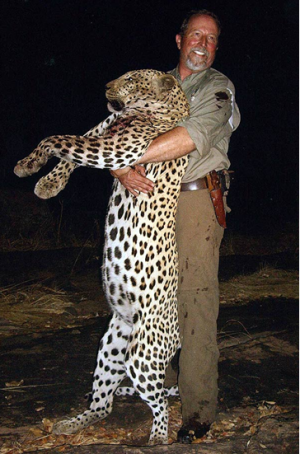News
Latest Lion Aid News
Leopard trophy hunting - anyone paying attention to the elusive and silent large cat?
Tuesday 20th December 2011
|
It is tragic, but nobody really knows how many leopards there are in Africa. Nocturnal, solitary, elusive – no counts or idea whatsoever. An unknown entity in terms of population numbers, but despite this greatly hunted. Supposedly all trophies are adult males (in actuality including subadult males and illegal females - in Tanzania, females comprised 28.6% of 77 trophies shot between 1995 and 1998). All leopards are hunted on bait, and even hunted with dogs in some countries. How many trophies? From 2000-2009, a total of 9,861 from the major exporting countries. This number is likely to exceed 10,000 with new CITES record updates. That is 1000 trophies per year. Skins? Add another minimum of 1135 from 2000-2009. In addition, CITES only records exports, and therefore these numbers do not include any information from trophies collected by resident hunters. Resident hunters are likely to have collected a significant number of additional trophies in South Africa and Namibia for example. The major trophy exporting countries were Tanzania (29% of total African exports), Zimbabwe (27%), Namibia (14% - with an increase of about 150% in exports over the last five years), and South Africa (11%). A few export surprises – Central African Republic with 340 leopards for example. The major trophy importing countries are the USA (49%), France (10%), Spain (8%), and South Africa (7%). Germany and Mexico trail with 5% each. Smaller numbers of imports were recorded by Austria, Belgium, Canada, Denmark, Italy, Portugal, Russia and Sweden. Throughout Africa, the major threats to leopard population numbers are said to be habitat conversion and intense persecution, especially in retribution for real and perceived livestock losses. But trophy hunting is a highly significant added source of mortality. Perhaps even the highest source of mortality as with lions. Leopard males are infanticidal, and constantly removing reproductive males from the population by trophy hunting will have a cascade effect on future leopard reproduction. The IUCN and CITES list African leopards as “vulnerable”, essentially placing them in their convenient but inappropriate and irresponsible category of “don’t pay much/any attention”. What can be done? African leopards have few supporters, they are the “silent cats” in more ways than one. Trophy hunters have benefited. Time for all to pay some due attention. Picture: www. huntingreport.com Tags: CITES, Namibia, South Africa, trophy hunting, Tanzania, Zimbabwe, leopards, Categories: Events/Fundraising, Trophy Hunting |
Posted by Pieter Kat at 14:40
No comments have been posted yet.
Add a new comment
Existing user
New user sign up




